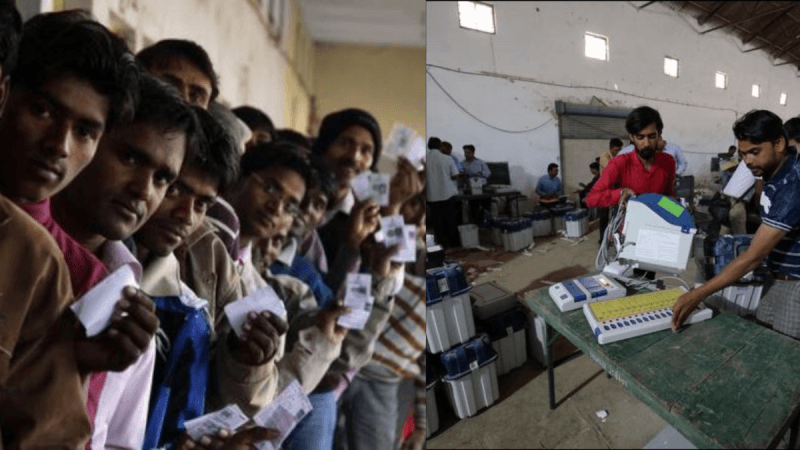
The 2019 Lok Sabha elections will begin on April 11 and continue for over a month till May 19. The general elections will be held in seven phases. The counting of votes will take place on May 23 and results will likely be announced on the same day i.e. on May 23, according to Chief Election Commissioner Sunil Arora.
Out of 90 crore voters eligible to vote, around 15 million voters are in the age group of 18-19 years. There will be approximately 10 lakh polling stations across the country as compared to 9 lakh polling stations in 2014. The 2019 general election will be the largest the world has seen.
The Model Code of Conduct came into effect immediately after the announcement. The verifiable paper audit trail (VVPAT) will be used with EVMs at all polling stations in India. VVPAT will be making its national debut at the upcoming elections in India. However, the EVMs have also been upgraded for the 2019 LS elections to the 'M3' third generation models.
The Election Commission of India gave out the schedule for 2019 Lok Sabha elections.

No assembly polls in J&K
Meanwhile, the assembly elections in Jammu and Kashmir will not be held along with the Lok Sabha 2019 elections.
2019 Lok Sabha election: Phase I
The Phase I of Lok Sabha polls will be held in 91 parliamentary constituencies spread across 20 states.
| Date of notification | March 18 |
| Last date of filing nomination | March 25 |
| Scrutiny of nominations | March 26 |
| Last date for withdrawal of candidature | March 28 |
| Polling date | April 11 |
| Result | May 23 |
2019 Lok Sabha election: Phase II
The Phase II of Lok Sabha polls will be held in 97 parliamentary constituencies spread across 13 states.
| Date of notification | March 19 |
| Last date of filing nomination | March 26 |
| Scrutiny of nominations | March 27 |
| Last date for withdrawal of candidature | March 29 |
| Polling date | April 18 |
| Result | May 23 |
2019 Lok Sabha election: Phase III
The Phase III of Lok Sabha polls will be held in 115 parliamentary constituencies spread across 14 states.
| Date of notification | March 28 |
| Last date of filing nomination | April 4 |
| Scrutiny of nominations | April 5 |
| Last date for withdrawal of candidature | April 8 |
| Polling date | April 23 |
| Result | May 23 |
2019 Lok Sabha election: Phase IV
The Phase IV of Lok Sabha polls will be held in 71 parliamentary constituencies spread across nine states.
| Date of notification | April 2 |
| Last date of filing nomination | April 9 |
| Scrutiny of nominations | April 10 |
| Last date for withdrawal of candidature | April 12 |
| Polling date | April 29 |
| Result | May 23 |
2019 Lok Sabha election: Phase V
Phase V of Lok Sabha polls will be held in 51 parliamentary constituencies spread across seven states.
| Date of notification | April 10 |
| Last date of filing nomination | April 18 |
| Scrutiny of nominations | April 20 |
| Last date for withdrawal of candidature | April 22 |
| Polling date | May 6 |
| Result | May 23 |
2019 Lok Sabha election: Phase VI
Phase VI of Lok Sabha polls will be held in 59 parliamentary constituencies spread across seven states.
| Date of notification | April 16 |
| Last date of filing nomination | April 23 |
| Scrutiny of nominations | April 24 |
| Last date for withdrawal of candidature | April 26 |
| Polling date | May 12 |
| Result | May 23 |
2019 Lok Sabha election: Phase VII
Phase VII of the Lok Sabha polls will be held in 59 parliamentary constituencies spread across eight states.
| Date of notification | April 22 |
| Last date of filing nomination | April 29 |
| Scrutiny of nominations | April 30 |
| Last date for withdrawal of candidature | May 2 |
| Polling date | May 19 |
| Result | May 23 |
The first phase of polling will be held on April 11, the second phase on April 18, third phase on April 23, fourth phase on April 29, fifth phase on May 6, sixth phase on May 12 and seventh phase on May 19 for 543 Lok Sabha seats across India.
| Phases | Polling Dates |
| 1 | April 11 |
| 2 | April 18 |
| 3 | April 23 |
| 4 | April 29 |
| 5 | May 6 |
| 6 | May 12 |
| 7 | May 19 |
What is NOTA and how does it impact the elections?
NOTA option is at the end of the list of candidates contesting in a constituency. The electors are free to use the negative ballot option. But, before opting for it, the voter needs to contact the presiding officer in a polling booth. The voter then has to cast their vote in a separate ballot paper and enter his/her name in a register.
Earlier, the Supreme Court said this system was unconstitutional as it failed to protect the voter's identity. The introduction of NOTA option in the voting machines does not require one should contact the presiding officer and it also helps maintain the anonymity of the voter casting it.
Minimum criteria for voting
- A voter should be an Indian citizen.
- He/she must be 18 years and above.
- The elector should be a resident of a polling area of the Constituency.
- The voter must have a valid voter id card issued by the Election Commission of India.
Election Commission joins Twitter
The ECI has joined Twitter to promote voter awareness ahead of the 2019 Lok Sabha elections. The account name, ECI #DeshKaMahaTyohar, will be used to make people aware of their voting rights. The EC's decision to open a Twitter comes days after Twitter introduced an election emoji, which has an image of Parliament with hashtag available in 12 different languages.
The Election Commission of India has also imposed strict limits on the expenditure incurred by candidates, not political parties, for their election campaigning.

















